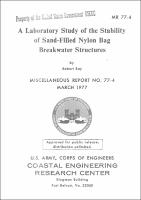Please use this identifier to cite or link to this item:
https://hdl.handle.net/11681/5148| Title: | A laboratory study of the stability of sand-filled nylon bag breakwater structures |
| Authors: | Ray, Robert E. |
| Keywords: | Breakwaters Laboratory tests Low-Cost shore protection Sandbag breakwaters Sandbag materials Waves |
| Publisher: | Coastal Engineering Research Center (U.S.) Engineer Research and Development Center (U.S.) |
| Series/Report no.: | Miscellaneous report (Coastal Engineering Research Center (U.S.)) ; no. 77-4. |
| Description: | Miscellaneous Report Abstract: One emergent and three submerged breakwaters built of sand-filled nylon bags on a sand bed were subjected to progressively more severe wave conditions in full-scale laboratory tests. The tests determined the properties of the bags, the effects of wave action on placement of bags, and the performance of bags and structures for various combinations of structure configuration and wave conditions. The changes in the sand bed at the base of the structures and the wave attenuation by the breakwaters were also investigated. The uncoated nylon material deteriorated after 1-year exposure to sunlight and was torn by handling equipment during breakwater construction. Wet material was slippery and trapped air. When filled with sand, the smooth, rounded bags, sometimes cushioned by an air bubble, failed to interlock adequately to prevent motion under the least severe wave condition. Bags were accurately dropped into place during wave action to construct one of the submerged breakwaters. During testing the structures' configurations changed drastically, primarily from movement of the bags during the first wave attack of the least severe wave condition and during the steepest wave condition. The two highest submerged breakwaters lost whole layers of bags from their crests, and the seaward face of the emergent breakwater slumped from a slope of 1 on 3 to a slope of 1 on 5.3. As wave conditions changed, scour and accretion occured alternately at the breakwaters' toes, but caused no measurable settlement. The emergent breakwater and the highest submerged breakwater, the two producing greater than 30 percent wave attenuation, underwent the most wave-induced damage. |
| Rights: | Approved for Public Release, Distribution is Unlimited |
| URI: | http://hdl.handle.net/11681/5148 |
| Appears in Collections: | Miscellaneous Report |
Files in This Item:
| File | Description | Size | Format | |
|---|---|---|---|---|
| MR-CERC-77-4.pdf | 25.15 MB | Adobe PDF |  View/Open |